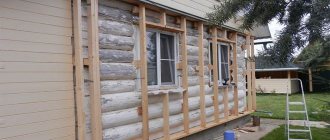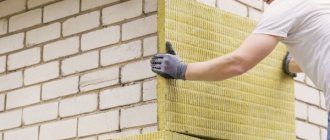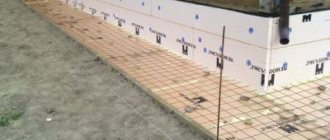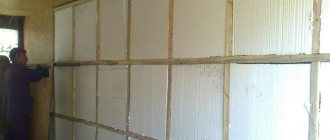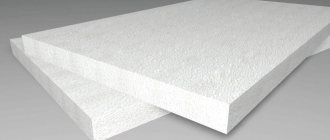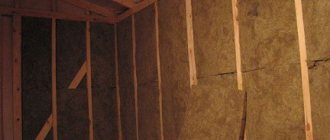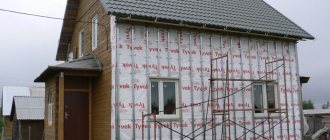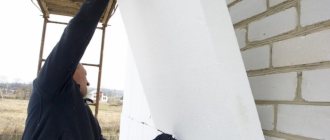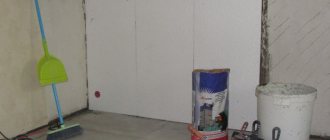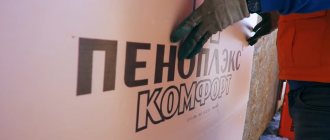Thermal insulation is necessary if the building has a basement or heated basement. It is also advisable to insulate an unheated room, especially if the height of the base is large enough. This will protect the walls and floors from freezing as much as possible. Insulating the foundation with polystyrene foam from the outside is an affordable and effective method. But it has its own disadvantages and limitations that must be kept in mind when building a house.
Why insulate the foundation
There are three main reasons for carrying out thermal insulation measures. The first is to reduce the building’s heat losses and increase the level of comfort. An insulated foundation allows you to reduce thermal energy losses and significantly save on heating costs. In addition, the floor in such a house will always be warm, even in severe winter.
The second reason is the fight against frost heaving. This phenomenon is typical for clay soils that retain water well. In winter, moisture in the soil freezes and increases in size (a unique property of water). In this case, increased pressure occurs on the foundations of the building, and part of the walls may rise. This will lead to cracks and deformations.
To prevent swelling, you need to exclude at least one of the factors of its occurrence: water or cold. Insulating the foundation with foam plastic allows you to maintain a positive temperature of the soil under the building and prevent the soil from freezing. This reduces the risk of damage.
The third reason lies in the additional protection of foundation structures from mechanical damage and other negative influences. Typically, thermal insulation is attached over a waterproofing layer. The insulation protects the moisture-resistant material and extends its service life, and, accordingly, the service life of the foundations.
Final stage
*
If part of the insulation protrudes from the trench, damage can be prevented by using a reinforced mesh. It is installed on the top insulation ball using the gluing method.
Next, you should treat the insulating layer with any finishing material. If the base structure is located flush with the soil, installation of the mesh and final finishing work will not be required. All that remains is to close the trench space with sand, earth or expanded clay, which also has thermal insulation properties.
Features of foam
Polystyrene foam or expanded polystyrene is a slab of small balls. This structure allows you to retain a large amount of air inside the material. It is this that has the best insulating properties (except for inert gases). Air is used in all heat insulators, in the manufacture of windows, etc.
The thermal conductivity of polystyrene foam is comparable to that of mineral wool and extruded polystyrene foam. The thickness is assumed to be almost the same.
But when choosing the material in question, it is worth knowing that it is afraid of the simultaneous action of moisture and cold. Manufacturers may be silent about this point, but when the liquid between the balls freezes, the foam crumbles into separate particles. Without proper waterproofing, such insulation will not last long.
Advice! When insulating the foundation, it is safer to use extruded polystyrene foam. This is the closest relative of polystyrene foam. It costs more, but has greater strength and moisture resistance. Does not require additional waterproofing.
The advantages of polystyrene foam include:
- accessibility and affordable cost;
- ease of cutting and installation;
- good thermal insulation performance;
- safety for humans (except in cases of fire, therefore it is applied only outside the building).
Expanded polystyrene is not recommended for use if there is a risk of flooding. The reason is poor resistance to moisture. At the same time, the balls themselves do not absorb liquid and are not afraid of it, as many manufacturers indicate. But the connections between them are easily destroyed by the action of water and sub-zero temperatures.
Why is it better to choose polystyrene foam?
Existing construction technologies today enable developers to use several types of insulation: liquid (foam), polystyrene foam, loose expanded clay or slag, expanded polystyrene. Why do we recommend polystyrene foam?
- Low thermal conductivity coefficient with relatively high physical strength. Production technology involves the use of special innovative additives to improve the performance characteristics of the material.
- Versatility of use. Expanded polystyrene can be used to insulate not only foundations (outside or inside), but also walls, ceilings, floors, etc. This greatly simplifies the building construction process and minimizes unproductive losses for insulation of the entire building. You can purchase the same type of insulation for all structures, including ceilings, walls and floors, and then use it based on the needs for each element of the building.
- Manufacturability. Expanded polystyrene is easy to cut and process; there is no need to purchase special tools and equipment for work. The slabs can be fixed with dowels and large caps or glued. The shelf life under proper conditions is practically unlimited. If for some reason the insulation of the foundation is postponed to a later date, the quality of the material will not deteriorate.
- Low price and long service life. In terms of the totality of these characteristics, polystyrene foam has no equal among all insulation materials.
XPS TECHNONICOL CARBON ECO
Unfortunately, there are also disadvantages: flammability, risks of damage by rodents and insufficient environmental performance. But these shortcomings can be easily eliminated by simple construction operations.
Insulation Penoplex Foundation
We will describe how this is done below.
Calculation of insulation thickness
Most manufacturers produce slabs with a thickness of 3 to 12 cm. Before insulating the foundation of a house with foam plastic, in each specific case a thermal engineering calculation is performed according to SP 50.13330.2012. This calculation takes into account the following initial data:
- type of structure (in our case, basement wall);
- outside air temperature;
- indoor temperature;
- operating mode of the building.
You can be guided by average values for a specific climatic region. In most cases, for central Russia, the thickness of the foam is 8-10 cm. In warmer climates, consumption can be reduced.
Diagram of heat loss through the foundation.
Advice! For accurate calculations, you can use special programs (for example, Teremok). In this case, it is possible to select an external wall as the calculated structure. But it’s worth checking the temperature and humidity indicators in the basement (they may differ from those indicated by default).
Which polystyrene foam should you choose?
A material such as polystyrene foam can be used to insulate the entire house : from the foundation to the roof. Therefore, there is material on sale with different qualities suitable for a specific place of implementation. There are three main brands of foam: PSB-S-15 foam, PSB-S-25 foam and PSB-S-35 foam.
Foam plastic of the PSB-S-35 brand is normally suitable for insulating the foundation. After all, foundation slabs must have protective sealed layers. Penoplast-S-35 is also called hybrid; it is very resistant to water.
When choosing expanded polystyrene for the foundation, you need to look for the special “Foundation” brand on the label.
This type of foam is also used for thermal insulation of attic spaces and floors.
Many experts believe that only extruded polystyrene foam is suitable for insulating foundations. This material does not rot and does not accumulate water. XPS is often used to insulate soils around foundations (to prevent freezing).
The only negative that XPS manufacturers prefer to hush up is that insulating the foundation with extruded polystyrene foam is quite expensive.
Preparatory work
Before insulating the foundation with foam plastic, it is necessary to prepare the outer surface. To do this, follow the following procedure:
- They dig out foundations to the depth of freezing.
- Clean the structure from dirt, dust, and soil residues.
- Prime the surface with a special compound. This layer will allow the wall and waterproofing to firmly adhere to each other. You can buy a primer (primer) in a store or make it yourself from a mixture of bitumen and fuel (diesel, gasoline). The mixture is prepared in a 1:1 ratio. The primer will take at least an hour to dry.
- The next stage is waterproofing. It will help protect the structure from moisture and premature destruction. It will also prevent basement flooding. Various materials are used as insulation. An inexpensive and popular method is coating with bitumen. But it can be replaced with more modern and reliable types, for example, liquid rubber or rolled material. Of the latter, linocrom, hydroisol, technoNIKOL, etc. are often used. Another replacement option is a waterproofing profiled membrane (not to be confused with a smooth one for roof insulation).
Another important event that is included in the general complex of works on insulation and waterproofing of the foundation is laying drainage. It is mounted just below the base of the foundation at a distance of no more than 1 m from the structure. Drainage pipes with a diameter of 10-20 cm are laid with a slope in a layer of crushed stone 200 mm thick on each side. Additionally, a layer of bulk material is wrapped in geotextile. This will avoid clogging the system.
Advantages and disadvantages of the material
The advantages of expanded polystyrene include:
- low thermal conductivity;
- soundproofing qualities;
- moisture resistance;
- light weight;
- ease of processing (it can be easily cut with a saw or knife);
- ease of fastening;
- excellent adhesion to other materials;
- frost resistance (withstands up to -50°C);
- safety during operation (expanded polystyrene does not smell, does not generate dust and does not emit toxic fumes);
- preservation of material properties for a long time (about 50 years);
- stability under high loads;
- no shrinkage;
- biological resistance (does not mold).
Advantages and disadvantages of expanded polystyrene
Disadvantages of the material:
- flammability (special additives make it self-extinguishing);
- may release harmful substances when ignited;
- low strength;
- hygroscopicity;
- inelasticity;
- instability to ultraviolet radiation.
Insulation comparison table
Insulation technology
A rigid base is provided for the bottom row of slabs. This could be a protrusion of the foundation, provided at the stage of pouring or assembly, or a sand and gravel backfill (well compacted). Insulation is carried out along the perimeter of the building, without breaks. It is advisable to do this along the entire height of the foundation. The minimum layer of heat insulation should go 1 m into the ground (for central Russia).
The foam is glued to the waterproofing using glue. This can be bitumen-polymer mastic or polyurethane glue. The composition is applied both over the entire surface and pointwise (at least 5 attachment points per slab). When choosing an adhesive, it is important to carefully study the composition. It should not contain substances that can damage the foam. This will affect the service life of thermal insulation, waterproofing and the entire foundation. Hazardous substances include:
- acetone;
- petrol;
- toluene;
- other organic solvents.
It is advisable that the packaging indicate that the composition is suitable for the work being carried out.
Foam plastic slabs are usually joined together into a lock. To do this, the manufacturer provides recesses and ridges around the entire perimeter. It is recommended to additionally coat the seams with mastic or glue. This will prevent the formation of cold bridges and the penetration of liquid.
Foundation insulation scheme.
The layout of the slabs is done in a checkerboard pattern. It is important that the vertical seams are not too long.
Important! Mechanical fasteners (fungi) are not used to insulate the foundation. This may lead to damage to the waterproofing.
After fixing the polystyrene foam, it is necessary to backfill. In order to prevent contact of the foam with the ground and its displacement during soil movements, an additional layer of rolled waterproofing, geotextile fabric, is used.
For backfilling, non-heaving materials are used: coarse or medium sand, sand and gravel mixture. The backfill is laid in layers with compaction. The thickness of one layer is 15-20 cm.
conclusions
Polystyrene foam is a common insulation material, the service life of which and its heat-protective characteristics are perfectly balanced. To increase the service life of the insulation, it is necessary to treat the material with anti-rodent impregnations during the insulation process and cover it with additional materials.
Installing polystyrene foam is quite simple, as it is easy to process and holds well on polyurethane foam and glue.
It is worth remembering that when working with this material, you cannot use glue or impregnations containing chemical solvents.

